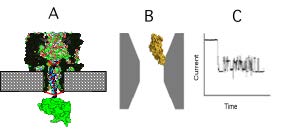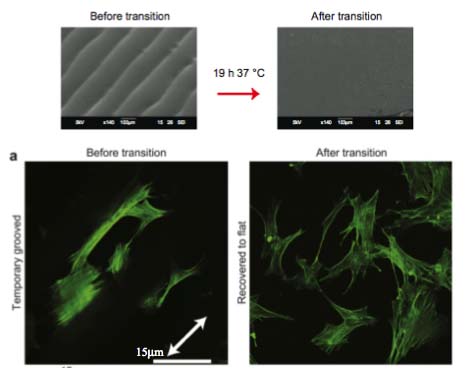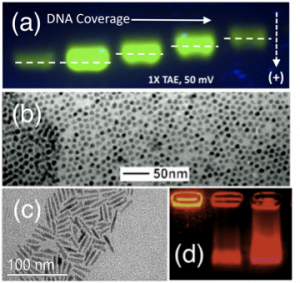The unifying research theme of the SU IGERT is Soft Interfaces. This theme encompasses research projects that span from the fundamental to the applied and provides a wonderful technical context for integrated training across the sciences and engineering. There are many opportunities for interdisciplinary research by students in this area at Syracuse University. Some of the projects also involve collaborations with researchers at other institutions, hence providing additional opportunities for student internships.
Within the theme of Soft Interfaces, collaborative research projects engaging the IGERT trainees have been organized into three areas.
Biological Membranes

Protein and synthetic nanopores are used to study transport and dynamics of proteins. (A) A folded protein transports across the interior of a protein nanopore engineered with electrostatic traps (red); (B) A folded protein is confined within a solid-state nanopore by spontaneous adsorption to its silicon nitride surface; (C) Real-time, single-channel current monitoring of single molecule conformational fluctuations. Movileanu Lab
The first set of projects aims at understanding the structure, function and dynamical properties of cell membranes – rich systems with surprising material properties that depend on both composition and degree of microscopic order. Biological membranes combine the fluidity of liquids with the structural integrity necessary for the cell membrane to perform its functional role as the cell’s encapsulating “skin”. This combination makes cell membranes a paradigm for materials science and raises questions from the fundamental to the applied.
The IGERT students will use a combination of model systems and living cells to quantify the role of the membrane’s composition, structural properties, protein channels and other inclusions in controlling chemical and mechanical cell-material communication.
Biomaterial Interfaces

Active cell culture substrate transitions from a grooved topography to a flat surface (top images). Cells were plated on a grooved substrate and allowed to attach. The substrate was then triggered to transition from grooved to flat. Bottom: Confocal images of cells stained with phalloidin show actin filaments (green) aligned with the groove direction (white arrow, left image) before substrate transition. After transition (right image) the filaments have rearranged and have random directions. Henderson & Mather Labs
This area of research aims at understanding the interaction of cells and living organisms with inorganic interfaces, a long-standing problem in bioengineering and medicine. At the single-cell level it is well known that cells sense and adjust to their chemical and mechanical environments, although a quantitative understanding of the cell response to substrate stiffness, surface chemistry, mechanical anisotropy and imposed stresses is still lacking. Even less explored is the collective behavior of dense groups of cells on elastic or viscoelastic substrates, which is of great interest for wound healing and tissue engineering. Finally, the formation of bacterial colonies and highly drug-resistant biofilms raises many fundamental questions and is of immense importance in medical applications. The IGERT students will have the opportunity to take advantage of expertise from physics, chemistry and bioengineering to address many fundamental issues in this field.
Nanostructured Interfaces

(a-b) Gel electrophoresis and TEM of synthesized and DNA-capped qdots. (c-d) Similar results for DNA-qrod assemblies. Maye Lab
Nanoparticles (NPs) and nanostructured materials have fascinating properties that are applicable, for example, in biosensing and imaging, as well as photovoltaics and electrocatalysis. While the synthesis and properties of individual NPs may exemplify “hard” chemistry and physics, the functionalization of their surfaces and their self-assembly into nanomaterials involve “soft” interactions and interfacial science. Students will have the opportunity to work on two broad classes of problems: (i) functionalization of semiconductive and metallic NPs to create “superatoms” with controlled directional bonding, and (ii) role of interfacial interactions and bonding in directing the assembly of functionalized NPs into materials with unexplored properties.
